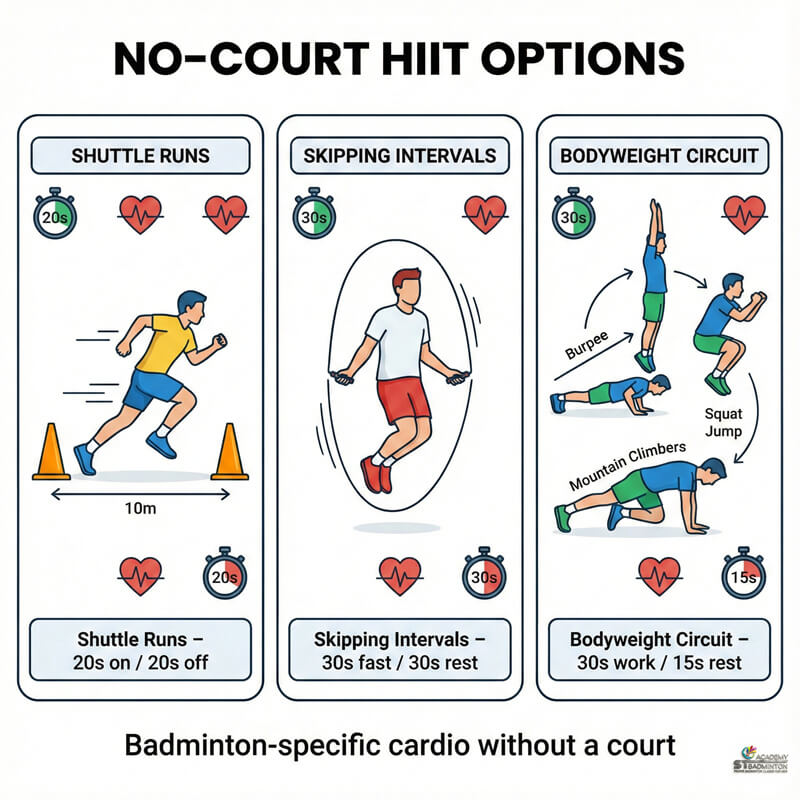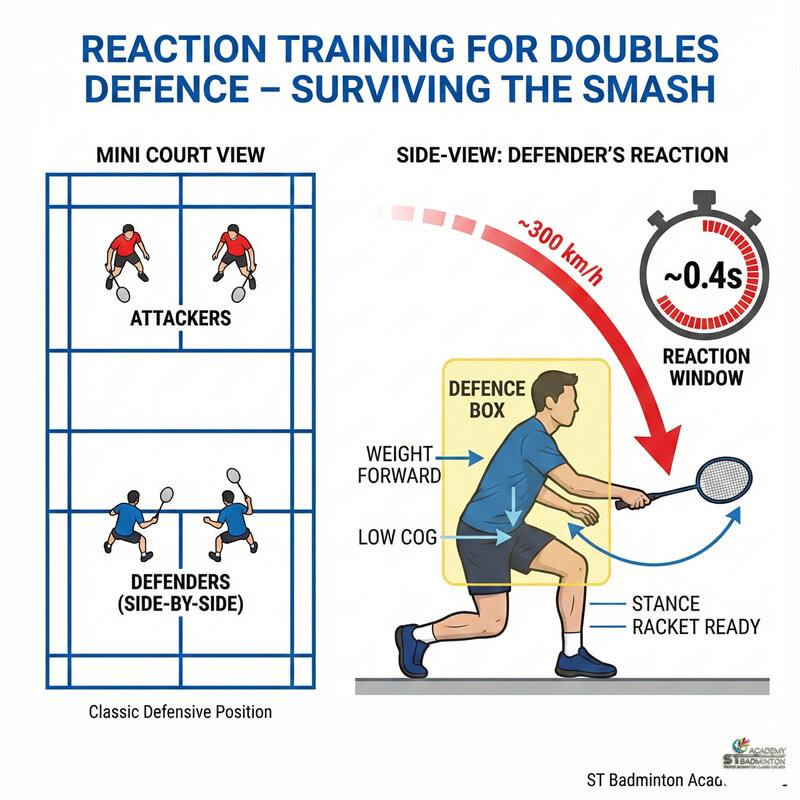Welcome to ST Badminton Academy’s badminton training in Malaysia! I’m here to talk about agility drills and how they can help you become a better player. As an expert in badminton, I know firsthand the importance of having great footwork and reaction time out on the court.
Being able to move quickly and make smart decisions is key to success in any sport, particularly when it comes to badminton. That’s why today I want to share with you some exercises that will help improve your footwork and reaction time – let’s get started!
Single-Leg Hops
Single-leg hops are the perfect way to improve footwork and reaction time for badminton and agility drills.
Like a frog leaping between lily pads, these jumps build strength in your legs while teaching your body how to move with lightning speed.
Bodyweight squats and medicine ball throws can help you prepare for single-leg hops.
By gaining more control over your lower half during those exercises, you’ll be able to propel yourself into the air with ease when it comes time to jump.
With practice, those leaps will become second nature – allowing you to focus on faster reflexes and better form as you continue along your path of success.
Ready to take off?
Let’s dive right into lateral jumps!
Lateral Jumps
Lateral jumps are an important part of any badminton and agility drill regimen. It’s one of the best ways to improve footwork, reaction time, coordination, and balance all at once!
Here are four quick tips for making sure your lateral jumps get you the most out of them:
Certainly! Here’s the information organized into a table:
| Tips | Description |
|---|---|
| Use skipping drills to warm up beforehand | This will help you maintain proper form throughout the movement. |
| Keep your feet close together as you jump side-to-side over a line or object on the ground | Maintain a close stance while performing lateral jumps. |
| Use small but powerful strides when performing lateral jumps | Focus on speed more than height to maximize the effectiveness of the exercise. |
| Incorporate side shuffles into your routine in between sets for added intensity | Adding side shuffles between sets increases the intensity of your workout and engages different muscle groups, contributing to overall agility and strength. |
Not only do lateral jumps provide great physical benefits, they can also be fun too! With just a few minutes dedicated each day towards improving your skills with these exercises, you’ll soon find yourself leaping further and faster then before.
This is true whether you’re preparing for a tournament or simply looking to stay in shape during leisurely play.
Ready to take it up another notch? Let’s move onto bunny hops!
Bunny Hops
Let’s talk about Bunny Hops, a great way to develop your footwork and agility.
I’ve been using these drills to help my athletes improve their reaction time and it’s been incredibly effective!
Bunny Hops
If you’re looking to improve your badminton footwork and reaction time, bunny hops are a great way to do just that!
Skipping drills and cross-over hops can help players learn proper form while also building their agility muscles.
Bunny hops involve hopping forward with both legs at the same time in order to move quickly around the court.
As you progress, try increasing the number of hops per jump or even adding some crossovers into your routine.
It’s an excellent exercise for learning how to react quickly on the court and improving overall speed.
So get out there and start hopping today–you won’t regret it!
Footwork Training
Other than choosing a good racket and also remember to choose the best badminton restring in Malaysia. Now that you’ve gotten your bunny hops down, let’s take it to the next level with some footwork training. It’s all about having good body balance and mastering those shuttle sprints.
With proper footwork drills, you’ll be able to move around the court more confidently while reacting quickly at a moment’s notice.
You can start off by doing simple exercises like hopping forward on one leg or running sideways in quick bursts–just make sure to stay light on your feet! Once you get comfortable, try adding in crossovers as well as different turns and spins for an extra challenge.
This type of agility training will not only help improve your badminton game but also increase overall coordination too. So don’t wait any longer – put on your shoes and hit the court!
Quick Feet Drills
As a badminton and agility drills expert, I’m always looking for the best ways to improve footwork and reaction time. One of my favorite exercises is quick foot drills. Shuffling drills are great because they help increase the speed in which you move your feet while also improving coordination. Quick stops are another way to work on reaction times and balance by allowing athletes to stop quickly when needed.
I like to use a combination of both shuffling and quick-stop drills with my athletes as part of their routine warm-up sessions. For example, one drill might have them sprinting five steps forward and then backpedaling three steps before quickly stopping. Another could be having them side shuffle left and right for ten yards before performing a series of 10 small jumps after each direction change.
These types of drills can really challenge an athlete’s stamina, strength, and endurance while simultaneously honing their ability to react quickly in any given situation during gameplay. Plus, it makes training fun! Without these drills, many players wouldn’t be able to reach their full potential on the court or field.
Reactive drills focus on how fast an individual can transition between movements such as starting and stopping suddenly or changing directions rapidly…
Reactive Drills
Having honed your footwork with Quick Feet Drills, it’s now time to take it up a notch and incorporate Reactive Drills into your training. When I’m working on agility drills with my players, focusing on reaction time is key.
Multi-directional hops are one of the best ways to train both balance and coordination – as well as improve reaction times!
Start in a standing position, then jump laterally over an imaginary line while keeping your center of gravity low. Then add in some shuttle hops for more of a challenge.
This drill requires you to react quickly while maintaining proper form – perfect for building fast-twitch muscles and increasing agility. Plus, it’s really fun too!
So get out there and start hopping around like crazy; your badminton game will thank you for it!
Frequently Asked Questions

What Are The Benefits Of These Badminton Agility Drills?
If you’re looking for a way to improve your footwork and reaction time on the badminton court, then balance drills and coordination drills are key.
Not only will these agility drills help you become quicker and more agile, but they also offer numerous other benefits that can take your game to the next level.
These include increased stability, improved flexibility in the feet and ankles, better hand-eye coordination, enhanced focus, as well as greater body awareness.
When practiced regularly, these badminton agility drills can make a huge difference to how quickly and confidently you move around the court!
How Often Should I Practice These Drills?
When it comes to how often you should practice these drills, the answer isn’t a one-size-fits-all solution. It largely depends on your skill level and goals.
If you’re just starting out, I’d recommend practicing two or three times a week for about 20 minutes each session.
For more experienced players, try increasing the duration of your exercises to 30 or 40 minutes per day and aim to practice four days a week.
Regardless of your skill level though, it’s important that you focus on muscle coordination as well as exercise duration while doing these drills – this will help ensure maximum improvement in both footwork and reaction time.
Is There A Specific Order I Should Do The Drills In?
When it comes to targeted drills and coordination exercises for improving your footwork and reaction time, there’s no one-size-fits-all approach.
Sure, you could just pick any drill randomly from the list and get some benefit – but if you’re looking to maximize your progress then it pays to think about a specific order that works best for you.
I recommend starting with simpler drills to build your foundation before trying more complex ones as this will help ensure that you’ve got the fundamentals down pat before moving on.
Additionally, try grouping similar drills together so that you can practice them in succession for maximum efficiency.
What Other Types Of Drills Can I Do To Improve My Badminton Footwork?
Did you know that over 70% of badminton players utilize some sort of agility drills when practicing their footwork?
For those looking to improve their quickness and reaction time on the court, there are a variety of drills available beyond the traditional exercises commonly used. Using equipment such as ladders or hurdles can help create different movement patterns while taking up minimal court space.
Adding in plyometrics, coordination games, balance activities, and even skipping will also build strength throughout your feet and ankles which is essential for any badminton player.
As an expert on badminton and agility drill techniques, I recommend creating a unique routine tailored to your individual needs and goals!
Is It Possible To Do These Drills With A Partner?
Sure, you can definitely do badminton and agility drills with a partner!
Partner drills are great for improving your footwork, as having someone else to react to makes the drill more challenging.
With two people, you can work on team drills that help each other’s reaction time and coordination. Plus, it’s just more fun when you have someone to practice with!
You should also be sure to include solo drills in your routine too – these will help you focus on refining specific movements without needing another person there.
Whether working alone or together, both types of drills will get you closer to mastering those perfect serve returns every time!
Learn Professional Agility Drills in Badminton Training Malaysia
Badminton and agility drills are an essential part of improving your game. Not only do they help you develop stronger footwork, but also improve your reaction time–leading to more successful shots on the court.
With regular practice, I’ve seen my students become significantly faster players in just a few months’ time. In fact, one student saw a 15% improvement in her badminton speed after two weeks of daily drill sessions!
If you’re serious about becoming a better player, then incorporating these badminton and agility drills into your routine is key. Start with 3-4 drills per day for best results and adapt them according to your own needs – whether that’s playing solo or with a partner.
Good luck – happy training!





